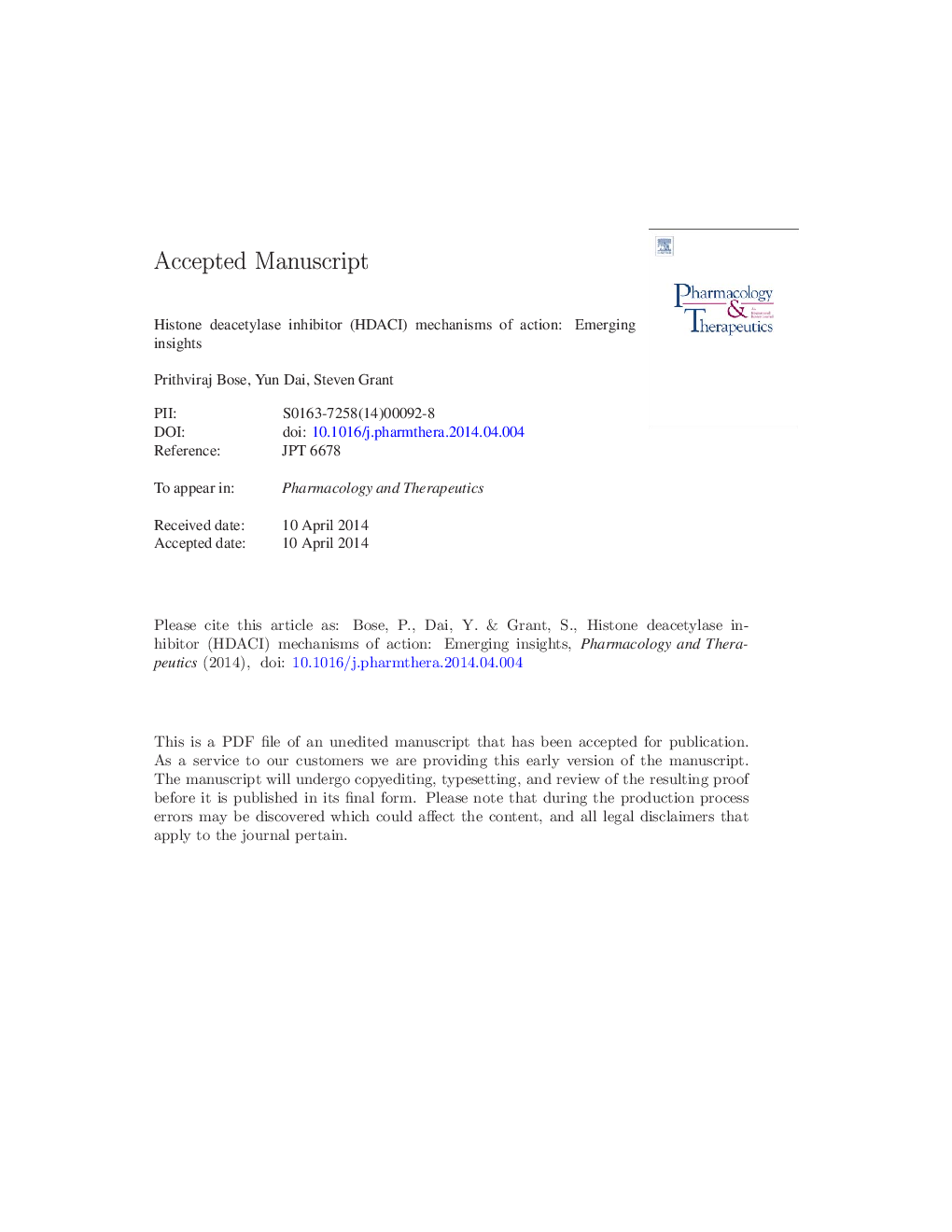| Article ID | Journal | Published Year | Pages | File Type |
|---|---|---|---|---|
| 5844008 | Pharmacology & Therapeutics | 2014 | 78 Pages |
Abstract
Initially regarded as “epigenetic modifiers” acting predominantly through chromatin remodeling via histone acetylation, HDACIs, alternatively referred to as lysine deacetylase or simply deacetylase inhibitors, have since been recognized to exert multiple cytotoxic actions in cancer cells, often through acetylation of non-histone proteins. Some well-recognized mechanisms of HDACI lethality include, in addition to relaxation of DNA and de-repression of gene transcription, interference with chaperone protein function, free radical generation, induction of DNA damage, up-regulation of endogenous inhibitors of cell cycle progression, e.g., p21, and promotion of apoptosis. Intriguingly, this class of agents is relatively selective for transformed cells, at least in pre-clinical studies. In recent years, additional mechanisms of action of these agents have been uncovered. For example, HDACIs interfere with multiple DNA repair processes, as well as disrupt cell cycle checkpoints, critical to the maintenance of genomic integrity in the face of diverse genotoxic insults. Despite their pre-clinical potential, the clinical use of HDACIs remains restricted to certain subsets of T-cell lymphoma. Currently, it appears likely that the ultimate role of these agents will lie in rational combinations, only a few of which have been pursued in the clinic to date. This review focuses on relatively recently identified mechanisms of action of HDACIs, with particular emphasis on those that relate to the DNA damage response (DDR), and discusses synergistic strategies combining HDACIs with several novel targeted agents that disrupt the DDR or antagonize anti-apoptotic proteins that could have implications for the future use of HDACIs in patients with cancer.
Keywords
Sirt1NF-κBCDKDSBJnkATRDDREToMEFNHEJMcl-1Bcl-2MCLHDACPMLMDSBERHspIκBBLMBMFHDACiIAPAPAf-1IKKDISCFADDITDBcl-xLPARPMRNGRP78ASK1I kappa B kinasesirtuin 1PLZFDLBCLLICTKICLLFOXM1c-FLIPRPAforkhead box protein M1XIAPCTCLmDC1RARαRunx1BCR-ABLATM and Rad3-relatedp53 binding protein 1p53-upregulated modulator of apoptosisFLT3Bcl-2 interacting mediator of cell deathSMACDIABLOSMRTNCOR1ATR interacting proteinCdc25Cdt1Bcl-2 antagonist of cell deathWRNMRE11Janus-associated kinaseCtIPPLK-1FDAFEN1Cellular FLICE-like inhibitory proteinRetinoic acid receptor alphaTNFAMLdirect IAP-binding protein with low pIXRCCbreakpoint cluster region-Abelsonleukemia-initiating cellmeiotic recombination 11ataxia telangiectasia mutatedc-Jun N-terminal kinaseDNANERMyeloid cell leukemia-1MAPKMdm2Mitogen activated protein kinase kinaseROSTip60STATdeoxyribonucleic acidRNAribonucleic acidpromyelocytic leukemia zinc fingerCell cycle checkpointscheckpoint kinaseBADBIKDNA repairnucleotide excision repairbase excision repairreplication protein Ainternal tandem duplicationApoptosisATMsecond mitochondria-derived activator of caspasesFood and Drug AdministrationATRIPHrkcell division cycle 25Bloom syndromeMyelodysplastic syndromesWerner syndromeendoplasmic reticulumdouble strand breakapoptotic protease activating factor 1non-homologous end-joiningFas LigandFasLtumor necrosis factornuclear factor kappa BTRAILBurkitt's lymphomaDiffuse large B-cell lymphomaB-cell lymphoma-2Mantle cell lymphomaCutaneous T-cell lymphomaPromyelocytic leukemiaacute myeloid leukemiaAcute lymphoblastic leukemiaChronic lymphocytic leukemiaTNF-related apoptosis inducing ligandMOMPHDAC inhibitorFMS-like tyrosine kinase 3Signal transducer and activator of transcriptionMEKBIMTyrosine kinase inhibitorhistone deacetylase inhibitorProteasome inhibitorinhibitor of apoptosisX-linked inhibitor of apoptosismouse embryonic fibroblastMultiple myelomaNADHomologous recombinationNAD, nicotinamide adenine dinucleotideALLHistone acetyltransferasehistone deacetylaseDNA damage responsePanoramaretinoblastoma proteinHeat shock proteinFas-associated protein with death domainProtein kinasemitogen activated protein kinasepoly ADP ribose polymerasePolo-like kinase 1PUMABIDdeath-inducing signaling complexChkJAKPhiladelphia chromosomeHATapoptosis signal-regulating kinase 1cyclin-dependent kinaseglucose regulated protein 78Reactive oxygen species
Related Topics
Health Sciences
Pharmacology, Toxicology and Pharmaceutical Science
Pharmacology
Authors
Prithviraj Bose, Yun Dai, Steven Grant,
